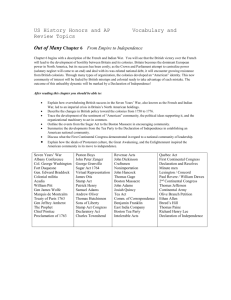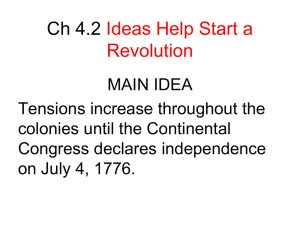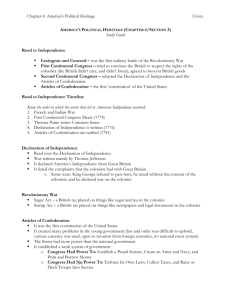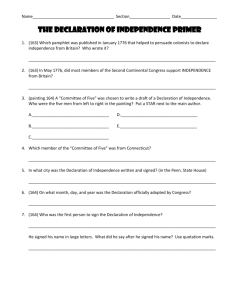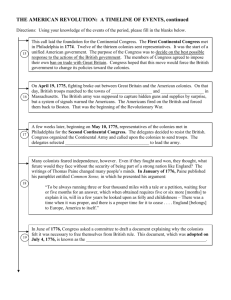6-4 Notes: Declaring Independence
advertisement
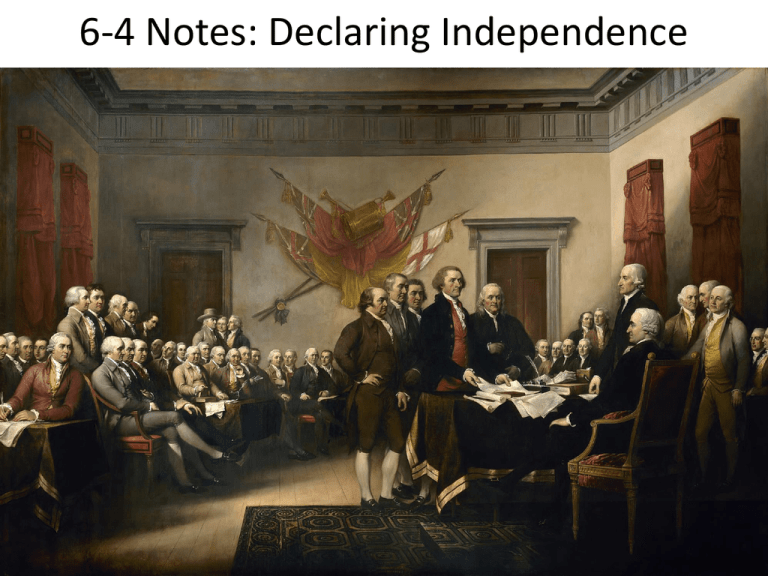
6-4 Notes: Declaring Independence • • • • • • • The Continental Army is Formed Militiamen from Massachusetts and other colonies began to gather around Boston after Lexington and Concord (around 20,000) General Gage moved his soldiers from the peninsula opposite Boston the city, thinking that an attack by land would be almost impossible May 10, 1775 ACE – Americans attacked Britain’s Fort Ticonderoga on the New York side of Lake Champlain Ethan Allen named a group of backwoodsmen known as the Green Mountain Boys, successfully capturing the fort and a large supply of artillery (cannons and other large guns) Same day – 2nd Continental Congress began meeting in Philadelphia (delegates included John and Samuel Adams, John Hancock, Benjamin Franklin, George Washington, and Patrick Henry. They agreed to form the Continental Army and George Washington of Virginia was chosen as the commanding officer Washington had served as an officer with the British during the French and Indian War. Congress also began to print money to pay the troops The Battle of Bunker Hill • Militiamen seized Bunker Hill and Breed’s Hill behind Charlestown (built fortifications on Breed’s Hill) • General William Howe crossed the bay with 2,200 British soldiers and marched up Breed’s Hill where the militia waited for them • “Don’t fire until you see the whites of their eyes!” – Colonel William Prescott (according to the legend!) • British fell back when attacked but eventually overtook the militia • The British won the Battle of Bunker Hill but suffered more than 1,000 killed or wounded, while the militia suffered only 400 casualties A Last Attempt at Peace • • • • • • Many still hoped peace could be salvaged with Britain July 1775 ACE – Moderates in Congress drafted the Olive Branch Petition, asking the king to restore harmony between Britain and the colonies The king rejected the petition and installed new measures to punish the colonies; he blockaded American ports with British warships to stop supplies, goods from going in or out, and hired thousands of hired German soldiers (called “Hessians” because of Hesse, a region in Germany where many of them came from) Washington knew his troops desperately needed training, supplies – began to train troops near the militia camp near Boston Fall 1775 – Washington approved a plan to invade Quebec in eastern Canada, defeat the British, and draw the Canadians onto their side After a grueling march across Maine, the Americans arrived at Quebec in November 1775 – winter quickly set in and the American attack failed in the harsh conditions The British Retreat from Boston • • • • • In Massachusetts, the Continental Army surrounded British forces in Boston Neither side broke the standoff; Cannons from Fort Ticonderoga arrived in Washington’s camp in January 1776 (took two months to haul them over the mountains covered in snow) Washington moved his troops and cannons to Dorchester Heights overlooking Boston General Howe and his 9,000 British soldiers departed Boston in more than 100 British troops, allowing the Patriots to retake the city More than 1,000 Loyalists left the city too because anti-British sentiment was so strong that they feared for their safety (their property and homes were seized) Common Sense is Published • Early 1776 ACE – publication of a pamphlet called Common Sense helped convince many Americans that independence was necessary • The pamphlet was written by Thomas Paine, a recent immigrant from England • Paine made fun of the idea that the king ruled by the will of God, calling George III “the royal brute” • Paine also argued that all monarchies are corrupt and that it made no economic sense to remain subjects of Great Britain • Common Sense sold over 100,000 copies in the first three months of its publication A Time of Decision • • • • • • • The Continental Congress remained undecided – a majority still could not agree to independence May 1776 – Congress adopted a resolution authorizing each of the 13 colonies to establish their own governments June 7th, 1776 – Richard Henry Lee of Virginia introduced a new resolution calling the colonies “free and independent states” and declared all political connections with Britain to be dissolved Congress appointed a committee (Franklin, Adams, Roger Sherman, Robert Livingston, and Thomas Jefferson) to draft a “Declaration of Independence” a The group chose Jefferson to write the Declaration because he was an excellent writer and from Virginia, a colony considered by many to be crucial to the success of any independence movement Jefferson wrote most of the document in two weeks On July 2, 1776, Congress passed Lee’s resolution The Declaration is Adopted • • • • • • • • July 4th, 1776 – Congress adopted the Declaration John Hancock, the President of the Congress, was the 1st to sign the Declaration Core of the Declaration based on the writings of English philosopher John Locke Locke wrote that people have unalienable rights, rights that government cannot take away When the government takes away those rights, people have the right to abolish it (by force if necessary) and form a new government to protect those rights The Declaration only intended to apply to free white men; women and slaves were left out of the Declaration Declaration also explained the reasons for breaking with Britain, and that the colonies were free and independent states From a British point of view, the Declaration was treasonous – the founding fathers knew that if they lost the war, they would be hanged

